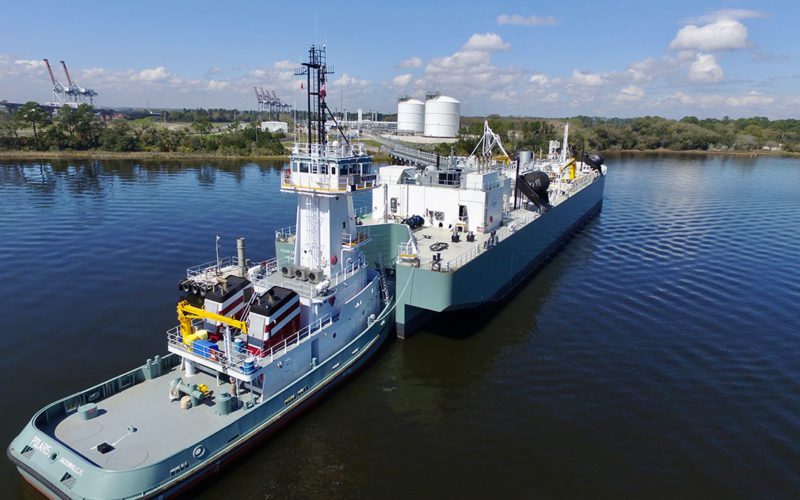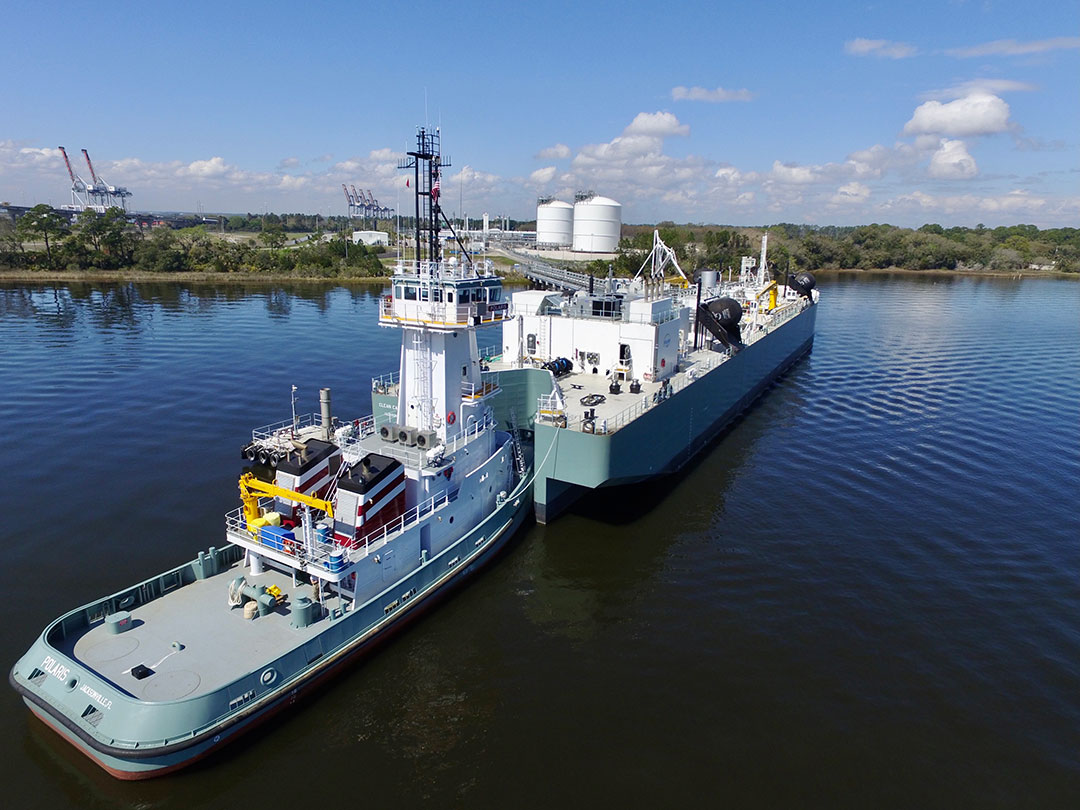
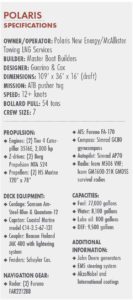 Polaris ATB helps meet demand for lower-carbon fuels
Polaris ATB helps meet demand for lower-carbon fuels
On a recent afternoon in Jacksonville, Fla., the pusher tug Polaris and its barge Clean Canaveral pulled alongside the tanker Eagle Brasilia, ready to supply the ship with liquefied natural gas (LNG).
The seamless process, which lasted about six hours, represent a small but important step in a global effort to reduce carbon emissions in commercial shipping.
Polaris and Clean Canaveral, together, are the second LNG bunkering articulated tug-barge (ATB) in the U.S. market. It is powered by Caterpillar Tier 4 engines driving Berg Propulsion z-drive thrusters that greatly improve its maneuverability.
The first purpose-built LNG bunker barge built in North America, Clean Jacksonville, was constructed by Conrad Industries for TOTE Maritime and launched in 2018. It can carry about 2,200 cubic meters of LNG. Q-Ocean Service was built by VT Halter Marine for Q-LNG Transport LLC and launched in 2020 as the world’s first ATB designed to bunker LNG, with a capacity of about 4,000 cubic meters.
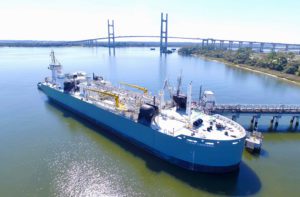
Clean Canaveral is the largest of the two bunkering ATBs. It can carry about 5,400 cubic meters of LNG. A couple other LNG ATB projects are currently underway to meet rising demand for the cleaner-burning fuel.
Polaris: Designed for maneuverability
Clean Canaveral, built by Fincantieri Bay Shipbuilding in Sturgeon Bay, Wis., is 340 by 66 by 33 feet. Driving it is the tug Polaris, which is 109 by 36 by 18 feet and built by Master Boat Builders of Coden, Ala. When combined, the ATB is 425 feet long. Guarino & Cox LLC of Covington, La., designed the tug. Chief naval architect Karl Keiger served as lead designer.
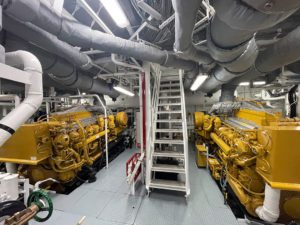
The company based the design on earlier Cape-class tugs, Keiger said. The propulsion system makes Polaris distinct. The vessel has two Caterpillar 3512E diesel engines that meet EPA Tier 4 emissions standards. They’re connected to Berg MTA 524 azimuthing thrusters.
“Due to the bunkering service that this ATB unit will be working in, there was more emphasis on maneuverability,” Keiger said. “So, the decision was made to go with z-drive propulsion for improved maneuverability.”
Designers also worked to keep the tug’s international gross tonnage below 500. The boat was designed with resilient engine mounts, dampening materials and other noise-reducing measures to increase crew comfort, he said.
The ABS-classed tug makes up to the barge through a JAK-400 coupler system supplied by Beacon Finland. Three John Deere 120-kW generators provide the tug’s electrical power.
In the event of a fire either on the barge or shoreside, the front of the tug’s tower is equipped with a remote-controlled Stang fire monitor capable of blasting 1,250 gallons per minute. In the unlikely event that the barge catches fire, the barge is outfitted with a Novec fire suppression system and the tug pilothouse is equipped with a water deluge system that drops a water curtain to protect the tug.
The firefighting system also includes multiple CounterFire Limited pumps. They’re driven by a power takeoff from the service generators.
“It’s always gratifying to see a project go from concept to completion,” Keiger said.
A sophisticated barge
Switching from diesel to a cleaner fuel has been a challenge for the maritime industry. Methane gas, for instance, greatly reduces emissions but takes up a lot of space. One solution involves liquefying the gas by reducing its temperature to minus 160 degrees Celsius.
Liquid methane takes up about 1/600th the volume of natural gas, making it a highly sought-after fuel for the maritime industry.
The liquid fuel is so cold it can damage tanks and piping during the initial commissioning process if it’s pumped too quickly, according to Marino Hwang, general manager of ATB operator McAlister Towing LNG Services.
Crews aboard Clean Canaveral prevented this potential problem by using a slow, controlled cooldown of the receiving ship’s tanks, he said. That barge-to-ship cooldown took about 36 hours, and saved the trouble of doing it at an onshore facility. It was the first barge-to-ship cooldown performed in the United States.
Because LNG constantly produces boil-off gas (BOG), pressure needs to be controlled. Clean Canaveral’s four cargo tanks each hold about 1,400 cubic meters of LNG. These C-type tanks can manage pressure on their own for 21 days. To add a layer of safety, Clean Canaveral is outfitted with a cryocooler built by Air Liquide.
“It basically takes the liquid from the bottom of our cargo tank and makes it even colder,” said Thomas Sullivan, senior vice president of operations for energy company Northstar Midstream and an affiliated company, Polaris New Energy, which owns Clean Canaveral.
“It is piped to the top of the tank like a sprinkler system in a warehouse,” Sullivan said. “Spraying super cold liquid into the space causes the BOG to reliquefy, safely dropping pressure and temperature.”
Each tank has a cargo pump, spray pump and multiple temperature and pressure sensors. Liquid flow is measured by a coriolis meter and piping is inerted via a nitrogen generator. The tug crew monitors and controls these components in the cargo control room.
Sullivan declined to share the cost of the barge — but it isn’t cheap. “We used to build 100,000-barrel oil barges. This 35,000-barrel LNG barge is more than four times as expensive to construct.”
Shipping industry moving toward LNG
Companies like Polaris New Energy see the maritime industry shifting toward LNG, with cruise ships, car carriers, container ships, chemical tankers and others adopting the cleaner-burning fuel. A key driving force is stricter pollution regulations from the IMO.
“Ships have the option of making modifications to their existing diesel engines by installing scrubbers and things like that on them,” Sullivan said. “And that’s what it makes sense to do that if your ship is six or eight years old. But if your ship is getting older, it makes more sense to then build a new ship that can run on liquefied natural gas.”
Polaris New Energy partnered with Pivotal LNG, an experienced LNG producer, and built an LNG bunkering facility near Jacksonville called JAX LNG. The bunkering facility is now owned 50-50 by Polaris New Energy and Warren Buffett’s company, Berkshire Hathaway.
When a big cruise ship company decided to build LNG-powered ships. It issued a request for proposals seeking companies to supply LNG. Sullivan paraphrased what his company said in response.
“JAX LNG can supply the LNG and oh, by the way, Timothy Casey and I ran a very large tugboat company for 30 years . . . And so not only can we provide the LNG, we’ll provide the marine transportation too,” he recalled.
After months of discussion, the company sought a shipyard to build the barge, and chose Fincantieri Bay Shipbuilding. They signed the contract in August 2019, and the yard delivered the vessel in December 2021. Because the LNG bunkering concept is still new, the company had to work closely with the U.S. Coast Guard and ABS create a capable vessel design.
Sullivan said he appreciated the help that the Coast Guard and the ABS supplied on the project. Even competitors in the LNG business helped by sharing information, he said, all with the goal of making the business safe and efficient.
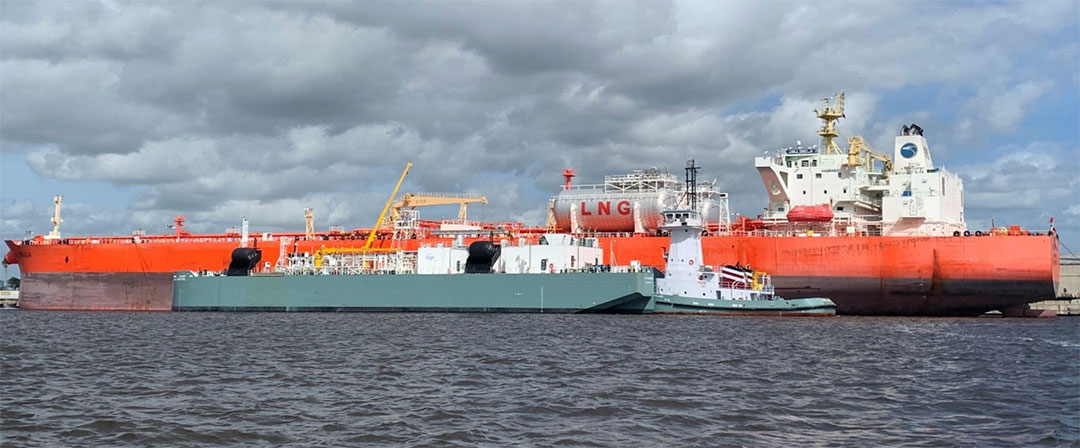
Operating the ATB
While Polaris New Energy owns the ATB, McAllister Towing of New York operates the vessel and employs the mariners that run it day to day. As of April, Clean Canaveral had already bunkered four vessels: the Aframax oil tankers Eagle Brasilia and Eagle Bintulu as well as car carriers Siem Confucius and Siem Aristotle.
“It can deliver to different vessels with different configurations and heights above water. The barge is very capable,” Hwang said.
The ATB performed the barge-to-ship cooldown maneuver for the two oil tankers. A key technology that makes the barge-to-ship cooldown process possible is a gas combustion unit onboard Clean Canaveral.
“The combination of the gas combustion unit and sub-cooler allows us to manage pressure and temperature,” he said. “Not all vessels are outfitted with both units, and this makes Clean Canaveral very unique. If you manage the pressure, you’re managing temperature because they’re directly correlated.”
He pointed to some other technical features of the ATB. For instance, the crew can remotely drop the barge anchor from the tug, and they can also run the LNG cargo system from the tug’s wheelhouse or its office. “And in the event that they would have to tow the barge, they also are able to do it via Wi-Fi — so over air, not through an umbilical.”
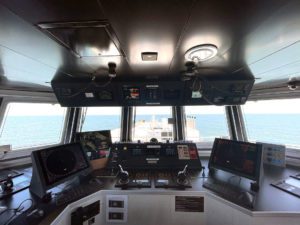
McAllister Towing employs two crews of seven mariners each to operate the vessel. Each works a 21-day rotation. One crew is captained by Jeff Serebrin, whom McAllister Towing recently recruited. The other crew is captained by Andrew Coffiey, a longtime McAllister Towing employee and SUNY Maritime graduate.
So far, the vessel has done its bunkering around Jacksonville, but its operator plans to make regular trips to Cape Canaveral — about 160 nautical miles away — in the future.
The mariners are highly trained: Wartsila conducted a five-day class on how to use its LNG systems, with half of each day spent in class and half onboard the vessel. The mariners also need certification from the Coast Guard to operate this vessel.
LNG can draw extra concern from the general public in part because it’s not well understood.
“I think everybody has this concern of liquid natural gas,” Hwang said. “But it’s a very safe and stable fuel. There’s a tremendous amount of safety and monitoring systems in place with backup systems and tertiary systems. And it’s a very safe operation.”
And he’s happy to be part of this project.
“This type of vessel and this fuel is really leading the way to help us move to a cleaner environment,” Hwang said. “Using LNG reduces the amount of greenhouse gases emitted by vessels and ships. It’s a very positive step forward to decarbonizing the marine business.” •

